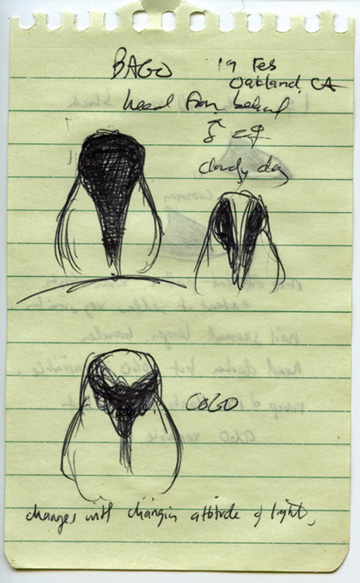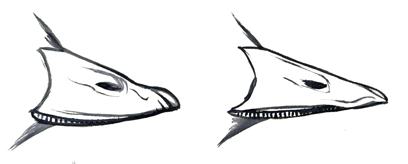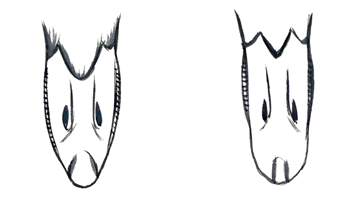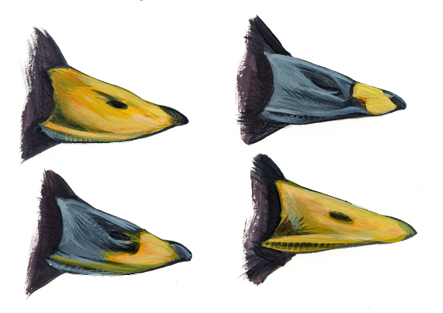Identifying female goldeneyes is extremely challenging. Differences are subtle, subjective, and inconsistent, but experienced observers still build up a “template” of expected impressions that allow them to identify the species with confidence. Describing these differences, and identifying individual birds from photos, can be very challenging because the process of identification relies so heavily on gestalt.
Here I have tried to describe the elements that go into the identification process. When watching a female goldeneye it is important to get good views, watch the bird as it moves around for some period of time, and pay special attention to details of head shape and bill shape. Determining the age of the bird can be helpful. Identification will be based on the sum of many small features.
Age determination
Through much of their first winter juvenile female goldeneyes have drab grayish or olive-yellow eyes, drabber brown head color, smaller heads, often drab olive bill color, and they lack black tips on the greater coverts. Adult females have bright yellow-white eyes, richer brown head color, larger heads with more distinctive species-specific shapes, brighter black and yellow bills, and have black tips on the greater coverts forming a narrow black bar across the white wing patch. Most of the ambiguous goldeneyes encountered will be immatures, and knowing the age can be very helpful in understanding the challenge.
Head shape
Head shape is often mentioned and emphasized in discussions and in field guides, but head shape is variable, ephemeral, and hard to describe. It is still important as part of the overall impression of shape and proportions, but to assess head shape properly you must watch the bird for a significant length of time, compare it to adjacent birds at the same angle that are doing the same things, and have a basic understanding of the variations in head shape.
The classic Barrow’s Goldeneye has a steep forehead rising sharply up from the base of the bill, and a flat crown sloping smoothly back down the nape to a long “mane”; the head seems to lean forward over the bill. The classic Common has a sloped forehead that more or less continues the line of the bill profile, rising to a peaked crown, and curving down to a less prominent “mane”; the head of Common is balanced, tall and triangular.

Juvenile females have head shapes slightly different from adults and less distinctive. The head feathers of juveniles are shorter and lack the exaggerated length on certain parts of the head, so the tall crown of Common or the long mane of Barrow’s are less obvious. Juvenile head shape of both species is generally rounded, and differences can be extremely subtle.
These classic head shapes are seen on relaxed birds with head feathers more or less erect. Active, diving, or alert birds show quite different head shapes. As the feathers are compressed against the head the tall forehead of Barrow’s and tall crown of Common disappear, both species have a smoothly rounded forehead and long sloping crown. The longer mane of Barrow’s is still evident, as is a small angle at the rear crown of Common.
Another potentially useful detail is suggested by my study of both species in Oakland California in 1990. Differences in head shape are revealed in shadows and highlights visible when the birds face directly away. Barrow’s show a long, smoothly tapered dark “tail” down the nape, while on Commons the corresponding feathers formed more of a “Y” shaped shadow. This was highly dependent on lighting, but is worth further study.

Derek Lovitch (in email) suggests that there may be a subtle difference in the shape of the head when viewed from front or back. He proposes that Barrow’s tends to have a narrower head and Common a wider “puffy-cheeked” appearance. This probably varies with age and sex, but I’ve drawn them that way in my field sketch above, and this deserves more checking in the field.
Bill Shape
Birders often emphasize the shorter bill of Barrow’s as a field mark, but this is a vague and overly simplistic description of the differences in bill shape and size. There is only a small average difference in bill size: Common averages longer-billed, Barrow’s shorter. Pyle (2008) gives measurements for exposed culmen of females as 31-37 mm in Common, 29-33 mm in Barrow’s. At the same time, the bill of Barrow’s averages slightly deeper than Common, so it is relatively quite a bit deeper and can appear stout and stubby. Even so, Fjeldsa (1993) plotted the ratio of bill length to bill depth and found that about half of the female goldeneyes in his sample fell in the zone of overlap. Even with calipers and a calculator, many goldeneyes can’t be identified by bill size.
Other details of bill shape are more useful. These may be visible only at close range, although they certainly contribute to an impression that is visible at a distance, and experienced birders use this impression without even knowing it. The nail on the tip of the bill is larger, broader, and more raised on Barrow’s. In addition, viewed from the side the lower edge of the bill of Barrow’s curves smoothly up to the tip; Common has a straighter bill with a slightly spatulate tip. In total, with curved lower edge and raised nail, the bill of Barrow’s looks slightly upturned, while the bill of Common looks straight.

Viewed from the front or from above the bill of Barrow’s is broader, and tapers abruptly to a narrower tip. The nail at the tip of the bill is larger and broader. Measurement of the width of the nail compared to the width of the bill allowed Fjeldsa (1993) to identify virtually all specimens, but this is not helpful in the field. Even at very close range the outline of the nail can be hard to determine, especially since coloration (e.g. dark nail on yellow bill) often does not match the contours of the nail.

An identification page by Environment Canada here mentions that on Barrow’s Goldeneye the nostrils are open so that one can see right through. On Common this is reportedly not possible. Under extraordinary field conditions this may be visible, as it was in Chicago on the bird described here. I have no personal experience with this and cannot comment for the reliability or the visibility of this feature.
Also note that juveniles average slightly smaller bills than adults.
Bill color
From about November to May nearly all females can be identified by bill color: on Common the bill is blackish with a small subterminal pale yellow patch; on Barrow’s the bill is mostly bright orange-yellow.

In summer, about June to October, the bills of female goldeneyes of both species are dark dusky or blackish, with the yellow color gradually reappearing in the fall. Adult females develop their full yellow color by November, juvenile females may not develop their full yellow color until February. Female Barrow’s Goldeneyes during this transition usually show a drab dusky yellow which gradually becomes brighter over the whole bill. A small but significant number of juvenile female Common Goldeneyes also develop a drab yellowish color over much or most of the bill, especially along the culmen ridge.
In North America Barrow’s very rarely have a blackish bill with small yellow band similar to Common. I have seen one in Oakland, California and one in Montana, identified as Barrow’s by shape and other features, but with Common-like bill pattern. The two that I have studied had yellow extending back towards the base of the bill below the nostril, unlike the more restricted narrow band of Common. Barrow’s Goldeneyes of the small and sedentary Icelandic population almost always have a small yellow band across the tip of the bill like Common, but these do not occur in North America, and there is no geographic pattern to variation in Barrow’s Goldeneye bill color within North America (Di Labio et al.1997).
Yellow-billed female Common Goldeneyes
Female Common Goldeneyes rarely but regularly have mostly yellow bills like Barrow’s. I have identified only three or four personally in the northeastern US, and one in California, but they are apparently more frequent elsewhere. Reportedly “several per year…one in several thousand” Commons in Minnesota (Karl Bardon, email to ID-Frontiers); 12-14 individuals in 14 years observation in Colorado (Tony Leukering, email to ID-Frontiers); 1-2 per winter in southern Maine (Derek Lovitch, pers. comm.); and they are seen regularly in eastern Ontario with at least several every winter (Di Labio et al. 1997; email). On the other hand, Shai Mitra (in email) reports experience similar to mine – that in the Long Island, NY to Rhode Island region yellow-billed female Common Goldeneyes are rarer than female Barrow’s.
Juvenile female Common Goldeneyes are much more likely than adults to show drab yellow or olive color over most of the bill. For example a bird photographed in Ontario in Nov (photos here) appears to be a juvenile female Common Goldeneye with a dull yellow-olive bill. I have seen birds like this (or with less extensive drab yellow patches) with some regularity. Many of the less obvious ones are overlooked or dismissed, and these yellow-billed immatures should be considered separately from adults. It is unknown how many of the reports of yellow-billed Common Goldeneyes pertain to juveniles, perhaps many of the reports enumerated above, and I suspect that adult female Common Goldeneyes with yellow bills are extremely rare.
My discussion of an interesting bird from New Jersey in Feb 2010 is here.
How many yellow-billed adult Common Goldeneyes are out there, and how many have been well-studied and well-photographed?
Do yellow-billed Common Goldeneyes of any age occur in the Eurasian population?
Hybrids?
Given that hybrid males are seen rarely but regularly throughout North America, it’s possible that at least some of the yellow-billed non-Barrow’s goldeneyes are hybrids. I suggest following the advice of Di Labio et al. (1997) “Although the probability of encountering a hybrid is remote, any female that does not show the classic features of a Barrow’s or Common Goldeneye should be left unidentified.” Actually identifying a hybrid female in the field would be virtually impossible, since pure females of the two species are so similar, but we should be open to the possibility that birds showing confusing combinations of features might be hybrids. (also see my post here).
Head color
Adult female Barrow’s has a darker, richer, more saturated brown head color, compared to a paler, “drier”, more orange-brown color on Common. The difference can be very subtle, and depends on lighting and angle of view, so this feature is most useful in direct comparison and must be confirmed by watching the bird at a variety of angles. Common may also have the tips of the longest nape feathers paler, appearing “frosted”, unlike the solidly dark Barrow’s (needs confirmation).
Juvenile females of both species have drabber, more gray-brown head feathers, so this feature is less useful on immatures.
Extent of dark color on neck
The fact that the dark brown head color extends lower onto the neck of Barrow’s than Common is often mentioned as a field mark. It may be useful when birds can be compared directly in good views, but it is extremely difficult to ascertain and is variable depending on the posture of the bird. It may also vary individually and with age (more study needed) and in my opinion deserves very little attention.
Wing pattern
Barrow’s has, on average, less white in the wings than Common. This is most easily determined by counting the number of white secondaries – 7 or more on Common, and only 6 or fewer on Barrow’s. In the field, the variation within each species, and the shifting appearance as the wing spreads and folds, makes this feature essentially useless. Even in photographs it is of very limited value. Compare the photos shown in Carney, 1992.
Overall size
Barrow’s averages slightly larger overall than Common (except in bill length) but there is considerable overlap, females average smaller than males, and immatures smaller than adults. In direct comparison with birds of the same age and sex this might offer some support for an identification, but even that limited use seems unlikely.
Psychology of perception
The identification of female goldeneyes is usually based on a subjective impression generated by the complex interplay of shapes and proportions of head and bill, supplemented by expectations and other subconscious factors. If we could mind-read the actual “data” and analysis from a birder, it might look like this:
- Bill length looks 75% like Common, 25% like Barrow’s [STARTING ASSUMPTION]
- forehead shape 70% Common, 30% Barrow’s [SUPPORTIVE]
- crown shape 60% Common, 40% Barrow’s [SUPPORTIVE]
- Mane 40% Common, 60% Barrow’s [IGNORE]
- Bill depth 40% Common, 60% Barrow’s [IGNORE]
- etc.
This is then verbalized in statements that are either very specific “It’s a Common because the bill is way too long for Barrow’s” or very broad “Everything I see looks good for Common and outside the range of Barrow’s”. While many Barrow’s fit the “classic” mold of small stubby bill, steep forehead, and long “mane”, many others do not. Every goldeneye will present a mixture of strong and weak signals. The things we choose to emphasize, and the impression we form of a bird’s shape is susceptible to all sorts of influences, and very subtle changes in one feature can influence our perception of others.
For example, apparent bill length is strongly influenced by the steepness of the forehead (a sloping forehead continues the profile of the bill and makes the bill appear longer). So when we look at two goldeneyes with identical bills, the one with the steeper forehead will appear to have a shorter bill. Similarly, when head feathers are compressed the head actually becomes smaller, making the bill proportionally larger. If we are focused on bill size, our first impression of bill size can influence how we interpret the rest of what we see.
Given that there is overlap in every feature between female Barrow’s and Common Goldeneyes, we should not expect bill size alone, or head color alone, or forehead shape, etc. to be a very reliable identification clue, particularly when our perception is influenced by other features. Identification has to be based on an overall assessment of multiple features.
References:
Carney, Samuel M. 1992. Species, age and sex identification of ducks using wing plumage. U. S. Department of the Interior, U.S. Fish and Wildlife Service, Washington, D.C. Jamestown, ND: Northern Prairie Wildlife Research Center. Online at . http://www.npwrc.usgs.gov/resource/tools/duckplum/index.htm (Version 05DEC97).
Barrow’s wing photos http://www.npwrc.usgs.gov/resource/birds/duckplum/bargldny.htm
Common wing photos http://www.npwrc.usgs.gov/resource/birds/duckplum/comgldny.htm
Di Labio, B., R. Pittaway, and P. Burke. 1997. Bill Colour and Identification of Female Barrow’s Goldeneye. Ontario Birds 15:81-85. pdf here http://www.jeaniron.ca/2010/FemaleGoldeneyes.pdf
Environment Canada. The Barrow’s Goldeneye: know how to recognize it. Website at http://www.qc.ec.gc.ca/faune/chasse/html/barrowsgoldeneye.html
Fjeldsa, J. 1973. Possible Female Hybrids between Bucephala islandica and clangula. Bull. British Ornith. Club, 93:6-9.
Martin, P. R. and B. M. Di Labio. 1994. Natural hybrids between the Common Goldeneye, Bucephala clangula, and the Barrow’s Goldeneye, B. islandica. Canadian Field-Naturalist, 108: 195-198.pdf online here http://post.queensu.ca/~pm45/papers/7.Martin_&_Di_Labio_1994a.pdf
Moores, Nial, and C. Moores. 2003. Separation of female-type Barrow’s Goldeneye Bucephala islandica and Common Goldeneye Bucephala clangula – more than just bill colour. Online at http://www.birdskorea.org/Birds/Identification/ID_Notes/BK-ID-Barrows-Goldeneye.shtml
Pyle, P. 2008. Identification Guide to North Anerican Birds: Part II. Slate Creek Press.
Interesting photos online
One apparent adult female Common Goldeneye with a yellow bill from Korea is described (with photos) by Moores and Moores here http://www.birdskorea.org/Birds/Identification/ID_Notes/BK-ID-Barrows-Goldeneye.shtml and certainly looks unlike a Barrow’s, but also not like a typical Common.
A bird from the Niagara River, ON, photos at http://www.jeaniron.ca/2006/femalecommongoldeneye.htm is very interesting. Identified as a yellow-billed Common, it seems to show the bill shape of Barrow’s. The drab bill color would be typical of an immature female Barrow’s.
Karl Bardon’s photo from Minnesota at http://www.pbase.com/karlbardon/image/121114670 is labeled a yellow-billed Common, and Karl says it looked similar to the Commons nearby, but that can’t be confirmed from that single photo, with head feathers compressed.
The New Jersey record described in my Jan 2010 post , is an adult female with a yellow bill, and although most reviewers identified it as “Common” without qualifications, I still think the photos are ambiguous, and several others also considered it ambiguous.
Several other records of yellow-billed goldeneyes were initially considered ambiguous but on further review and expert opinion were identified as Barrow’s:
Discussion of a yellow-billed goldeneye Feb 2009 in Chicago, IL, at first unidentified but then accepted as Barrow’s: Online at http://www.ilbirds.com/index.php?topic=16689.0 and a summary discussion online at http://www.ilbirds.com/index.php?topic=16875.0
Morlan, J. 1998. Mystery Bird. Online at http://fog.ccsf.cc.ca.us/~jmorlan/feb.htm
A yellow-billed Barrow’s in Massachusetts originally questioned but then accepted as a Barrow’s: Online at http://www.brewsterslinnet.com/nature/birding/2008/12/28/yellow-billed-goldeneyes.html and
http://www.brewsterslinnet.com/nature/birding/2009/01/02/goldeneye-again.html
with another good set of photos online at http://www.flickr.com/photos/rhode2boston/3168456385/in/photostream/


Dear sir,
On 13 May, Mr. Noam Weiss, reported of a female Goldeneye at Eilat Sewagde Farm, which is a very big rarity in Israel with only a 2-3 reports over the last 10 years.
When I reached the place later the day, i noticed that the bird is a young female and that both bill shape and head pattern falls within the extremes of both Barrow’s and Common Goldeneyes with respect to size and structure.
I have no experience with Barrow’s (which was never reported in Israel at all) and a very limited experiene (one sightings) of Common.
I will appreciate your comments and thoughts about the identification of the bird.
Photos can be seen in the following link
http://www.tapuz.co.il/forums2008/forumpage.aspx?forumid=1002&r=1
http://db.tt/hyZQ8o0c
Here is the corrected link for the bird photo
http://img2.tapuz.co.il/forums/1_161685062.JPG
Good afternoon. I am in Oregon, which is the southern end of the Barrow’s Goldeneye winter range. There have been several pictures of atypical goldeneye’s posted on our state list service recently. If you have time, please consider adding your expertise to the discussion.
OREGON LIST http://birding.aba.org/search.php
ASTORIA GOLDENEYE http://www.flickr.com/photos/mbalame/archives/date-posted/2013/12/15/?view=lg
– See more at: http://birding.aba.org/message.php?mesid=581455&MLID=OR01&MLNM=Oregon#sthash.ADUF9yD1.dpuf
Pingback: What was that Bird? #2